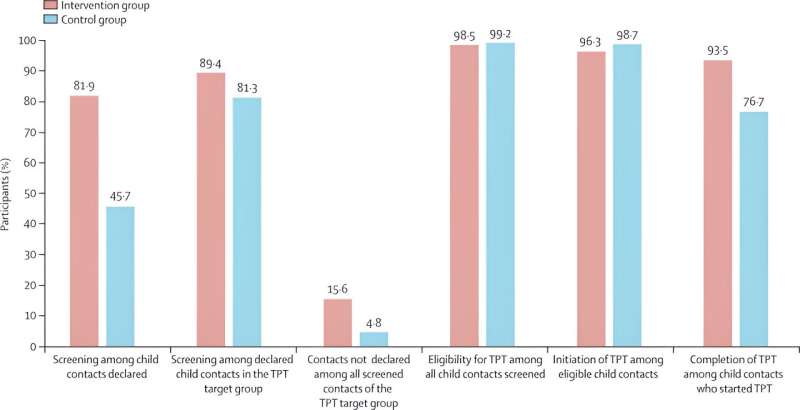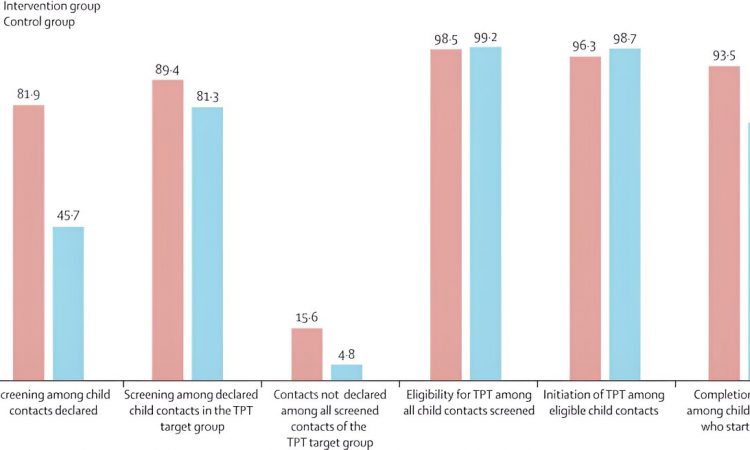
The Lancet Global Health journal published two papers on October 30 showing the effectiveness and health economical impact of community-based intervention for household child contact management. Led by the French National Research Institute for Sustainable Development (IRD), the CONTACT study for COmmunity iNtervention for Tuberculosis Active Contact Tracing and preventive therapy, was part of the Elizabeth Glaser Pediatric AIDS Foundation (EGPAF)’s CaP-Tuberculosis (TB) Project.
The study, performed in Cameroon and Uganda in collaboration with Epicentre in Uganda, EGPAF in Cameroon and National Tuberculosis Programs of both countries, sought to introduce innovative models of care to address the diagnostic and prevention gaps in children affected by or exposed to TB. The University of Sheffield evaluated the cost-effectiveness of the CONTACT study intervention.
The World Health Organization (WHO) estimates that more than 1 million of children are suffering from tuberculosis each year but less than 40% of them have been notified to WHO by national tuberculosis programs in 2021, mainly because they are not diagnosed. Identifying people who have been exposed to tuberculosis (contacts) and ensuring that they are screened for tuberculosis critical to ensuring early diagnosis and, thereby providing tuberculosis preventive treatment (TPT) for those who are living with or at risk for TB infection.
Child contacts under 5 years old and individuals living with HIV are priority target populations for TPT because they are at a higher risk of getting sick and dying of TB. In 2018, Member States committed to provide TPT to 4 million child contacts under 5 years of age by 2022 yet only 55% of this target was met as reported at United Nations High Level Meeting on TB in September 2023.
Despite available evidence and recommendations, contact investigation remains poorly implemented in many high TB incidence and resource-limited countries due to operational challenges such as a lack of financial investments and limited human resource capacity. A key challenge affecting the coverage of contact investigation is the necessity for parents to bring child contacts to the health facility for TB screening and management of TPT. Community-based approaches for household child contact management could increase the contact investigation coverage and TPT uptake by bringing those services closer to the people in need and reducing the financial burden.
The CONTACT study is the first cluster randomized controlled trial to evaluate a community-based intervention for tuberculosis screening and TPT management of household child contacts by community-health workers. The study compared its effectiveness, feasibility, and cost-effectiveness to the facility-based standard of care.
The study was performed in Cameroon and Uganda and shows that community-based contact investigations performed by community-health workers increases the coverage, initiation, and completion of TPT among child contacts under 5 years old or 5–14 years old children living with HIV. The proportion of child contacts of all ages who were screened for TB increased from 47.3% in the standard of care arm to 81.9% in the intervention arm and the proportion of child contacts in the TPT target group that initiated and completed TPT increased from 61.7% in the standard of care arm to 79.9% in the intervention arm.
The intervention prevented 15 tuberculosis deaths in Cameroon and 10 in Uganda. The incremental cost-effectiveness ratio was $620 per disability-adjusted life-year (DALY) averted in Cameroon and $970/DALY averted in Uganda. The intervention in Cameroon and Uganda would be considered cost-effective at willingness-to-pay thresholds of $1,000/DALY averted. In addition, as previously reported the intervention significantly reduced the median household cost as compared to the standard of care in both countries.
The CONTACT study confirms that decentralizing contact investigation at the household level using community-health workers is feasible and effective in improving child contact screening coverage, TPT uptake and completion as compared to facility-based standard of care. Impact and cost-effectiveness of such interventions would be greater in settings with higher TB disease prevalence among contacts and lower for existing coverage of screening for child household contacts. Decentralizing contact investigations at household level is likely to contribute to filling the TB case finding and prevention among children and can play a critical role to reach the targets set for 2027.
As a player on the international development agenda, IRD’s priorities are focused on achieving the Global Goals.
These studies concern target 3.3, dedicated to fight communicable diseases and “by 2030, end the epidemics of AIDS, tuberculosis, malaria and neglected tropical diseases and combat hepatitis, water-borne diseases and other communicable diseases.”
More information:
Maryline Bonnet et al, Effectiveness of a community-based approach for the investigation and management of children with household tuberculosis contact in Cameroon and Uganda: a cluster-randomised trial, The Lancet Global Health (2023). DOI: 10.1016/S2214-109X(23)00430-8
Nyashadzaishe Mafirakureva et al, Cost-effectiveness of community-based household tuberculosis contact management for children in Cameroon and Uganda: a modelling analysis of a cluster-randomised trial, The Lancet Global Health (2023). DOI: 10.1016/S2214-109X(23)00451-5
Journal information:
The Lancet Global Health
Source: Read Full Article
